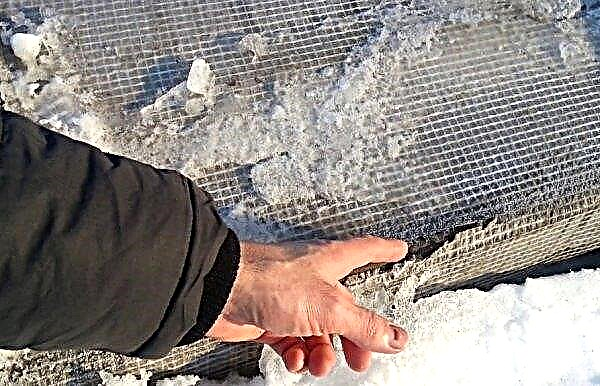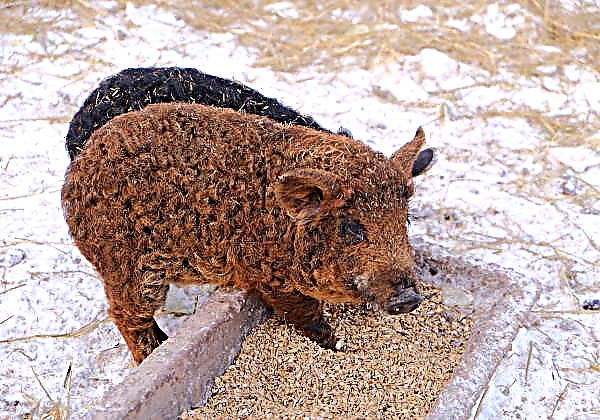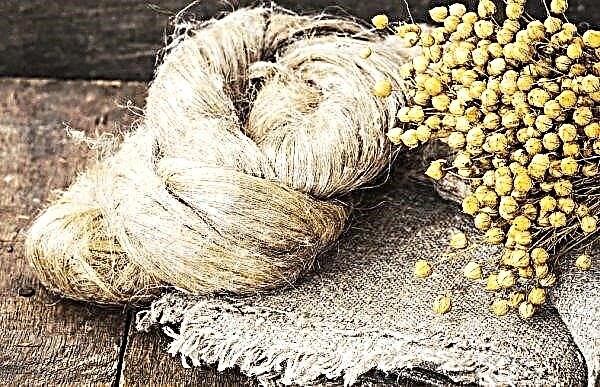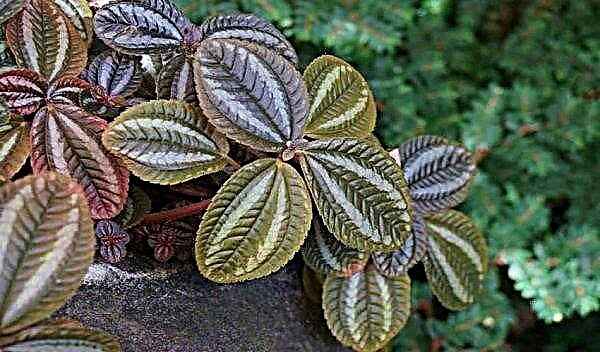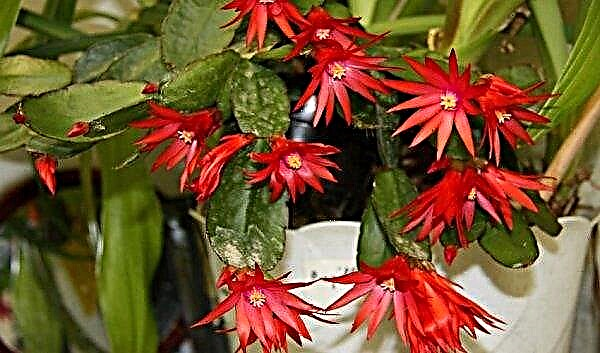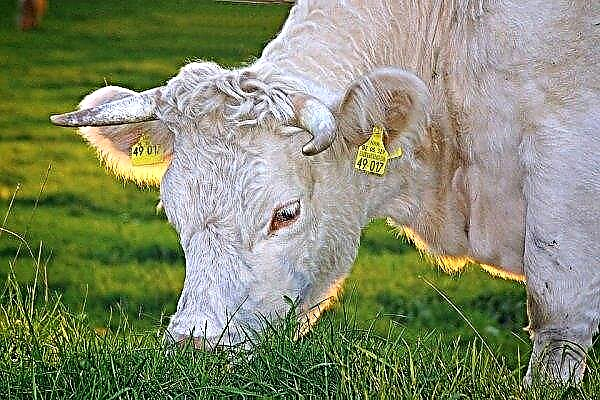Gloriosa is a winding flowering plant that is characterized by high growth rates. In home cultivation, a crop is demanding that a large amount of nutrients be present in the soil. About which fertilizers are better to use, when to apply them and other features of the care for gloriosa, read below.
Botanical description of the plant
Gloriosa is a perennial perennial plant. It is found in natural conditions in the humid tropical forests of Africa and India. In our country, it is able to grow in open ground in the southern regions, in the remaining areas, gloriosa are cultivated as houseplants. The rhizome of the plant is narrowed tuberous, reaching 20-30 cm in length. The root is covered with a dense brown dense bark.
In natural habitats, the ground part dies in the winter, in the spring it starts to grow again. The shoots are fragile, covered with soft bark of a bright green color, reach a length of 2 m at home, 5 m in the wild. Leaves are localized in internodes located close to each other.
Leaves are lanceolate with a pointed end of a dark green color. The central vein of the leaf is pronounced. Mustaches are located at the ends of the leaf plates, with the help of which the shoots are fixed on the supports. It enters the flowering phase in June, leaves it in September.
Did you know? Cut flowers of gloriosa remain decorative for 7 days. This allows you to use them in the preparation of various compositions.
The flowers are large, resembling daffodils or lilies. In the central part, 3-5 long whiskered stamens are located, the petals are bicolor (except yellow gloriosa - it has solid flowers), bright, bent up. After pollination, large trihedral seed capsules containing red seeds ripen in place of the flowers.
Gloriosa includes 5 varieties:
The Benefits and Poisonous Properties of Gloriosa
Gloriosa is a poisonous plant. All its parts secrete colchicine, which, when ingested, leads to severe intoxication, including death. In medicine, the extract of gloriosa is used to create drugs intended for the treatment of gout, blood diseases and oncology.
Optimal conditions for growing
Cultivating gloriosa at home, you need to take care of creating a comfortable microclimate close to natural:
- temperature condition - in the summer +20 ... + 35 ° С, in winter it is necessary to ensure a decrease in temperature indicators to + 5 ° С;
- lighting - plentiful, scattered, exposure east and southwest;
- air humidity - 60–80% in the summer, 40–50% in the winter;
- soil moisture - moderate in the range of 50-60%.
Important! Gloriosa does not breed in parts of the tuber. If the only kidney on it is damaged, the plant dies, so be extremely careful when transplanting.
Features and landing technology
Gloriosa planting is carried out in February. Grow a flower from seeds and tubers. First of all, you need to pick up a pot. It is better to give preference to shallow clay containers.
Step-by-step instructions for planting seeds:
- Soak the seeds in warm water (temperature +20 ... + 25 ° C) for 24 hours.
- Treat planting tanks with chlorine, wash and dry.
- Prepare the soil by mixing in equal proportions peat, humus, sand, sod-leaf soil.
- Disinfect the soil by roasting in an oven at + 50 ° C.
- Cover the bottom of the pot with a layer of small pebbles, fill the remaining volume with soil.
- Make indentations 0.2–0.4 cm.
- Place 1 seed in each pot and cover them with soil, moisten with a spray bottle.
- Cover the containers with polyethylene.
Video: planting gloriosa from seeds
During the germination period, tanks are installed in medium-light rooms in which the air temperature is maintained within +24 ... + 30 ° С. Daily planting should be aired until sprouts appear. When cultivated in warm regions, gloriosa is sown in rows in open ground, bypassing the stage of seedling germination. A distance of 10 cm is maintained between the plants and 40 cm between the rows. Next to each plant, supports in the form of stairs made of plastic of 1-2-meter height are installed.
Important! With the propagation of gloriosa by seeds, flowering occurs only for 3 years from the appearance of the first seedlings.
Step-by-step instructions for planting tubers:
- Prepare the pot and soil according to the instructions above.
- Soak tubers in a growth accelerator. You can use root.
- Organize quality drainage in the tank.
- Make a recess in the soil that matches the tuber in depth.
- Place the tuber upright, with your sleeping kidney up.
- Cover the tuber with 3 cm of soil.
- Moisten the soil.
Video: planting tuberous gloriosa
The container with the tuber is cleaned in a dark room and the temperature is maintained within +15 .. + 20 °. With the advent of the first sprouts, plants begin to accustom to light. To do this, the containers are rearranged to a constant location at first for an hour, increasing the time interval every day. In the spring, you can rearrange the plants on the balcony, creating a quality shade from the midday sun. During the period of active vegetation, the main tuber forms several additional ones, which, after drying of the ground part, are separated and stored in a peat substrate until spring.
Growing and caring at home
A tropical plant is demanding on moisture and fertilizing. Next to the plants, you need to install a thick support frame and tie shoots to it with a thin wire.
Watering and fertilizing
Especially abundant watering should be provided to the plant during the flowering period. Water can be taken for the defended or harvested rain. Water temperature for irrigation should fluctuate within +18 ... + 20 ° С. Watering is carried out under the root. Also, plants need to conduct a regular shower by spraying from a finely divided spray. Humidification is carried out after the top layer of soil is dried to a depth of 1 cm. In the autumn period with the end of flowering, reduce the irrigation intensity to 1-2 times a week, and in winter, refuse to moisten the soil.
Top dressing is applied 3-4 times a month from the moment the first 2 full-fledged leaf plates appear until the end of August. Universal fertilizers for palm trees and slurry are suitable. Minerals and organics alternate through time. Minerals are applied according to the instructions specified by the manufacturer, the organics are diluted 1: 2 with water and 400 ml are added under each bush.
Pruning
Pruning vines is not needed. The plant forms flowers only at the ends of the shoots, so when they pinch, flowering will come later. Standardly thin shoots are fixed on supports of various types. You can try the option of growing gloriosa as an ampoule bush, but in this case, you will also need high-quality support, since fragile stems will break under their own weight.
Transfer
In February, wintering tubers are planted in separate larger containers. The technology is similar to landing.
Breeding methods
Gloriosa at home is propagated in 2 ways:
- by seeds;
- tubers.
From seed
Seed boxes after dying off the ground part of the plant do not open, but are stored in a paper bag on the refrigerator door. At the end of February, the seeds are removed from the boxes and kept for 10 days in a dry, closed cabinet at a temperature of +15 ... + 20 ° С. When planting in open ground, not involving the cultivation of seedlings, the procedure for drying the seeds is shifted to mid-April.
Tubers
Daughter tubers from the main one can be separated in the autumn after the dying of greens or in the spring immediately before planting. Do this with a sharp knife, pre-treated with a 3% solution of furatsilina. Places where tubers are damaged during separation must be treated with charcoal.
Flowering period and dormancy
Gloriosa has a long flowering period. Buds are formed at the ends of the shoots and are quickly replaced by new ones. Over the entire flowering period, one shoot gives 4-7 flowers in turn. With the end of flowering, in early September, the foliage turns yellow, and the stems gradually dry out. After dying off the ground part, the tubers are left in the same soil, watering is completely excluded and put in a dark room where the temperature is maintained at + 5 ° С. You can remove the tubers from the substrate, divide them into daughter tubers, place them in a common container with peat and send them to be stored on the refrigerator door.
Did you know? Gloriosa has the ability to suppress negative emotions. According to Feng Shui, it is better to place the plant in the living room.
Growing difficulties
High humidity often causes the appearance of powdery mildew. This is the only disease that affects gloriosa. The treatment is fungicide treatment. First of all, you need to remove the affected parts of the plant and carry out the treatment with foundationazole. 10 g of substance are added to 5 l of water. Spraying is carried out three times with an interval of 20 days.
Of the pests in gloriosa can settle:
Gloriosa refers to plants of medium difficulty growing. It requires special care during the period of active vegetation.

